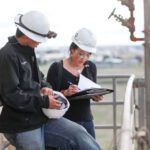Utilizing new technologies in today’s business environment is a necessity for operations leaders looking to optimize their resources. Smartphones, GPS, radio-frequency identification (RFID), on-demand/cloud computing, barcodes, scanners, and the latest generation of tablet computers are among the abundance of technological advancements available for tracking and managing operations in the power generation industry. These new technologies take into consideration the constant, innate challenges that operations leaders face and turn those challenges into useful tools.
New technologies can be daunting, especially when there are so many for companies to consider. The following tips can aid in deliberating the best optimization of electronic solutions or field service providers.
The Paperless Process
A starting point for improvement in field operations is transitioning to a paperless environment. This strategy began by scanning paper tickets, receipts, or documents so that an electronic copy could be represented. This then evolved to structured data on devices from information input, which could then be later referenced or even distributed in reports. As technology advances, so do the approaches to solutions for easier operations. What follows are a few of those solutions involved in complete mobile field operations.
Entirely Electronic with Error Reduction. Imagine losing $10 for every paper document generated by field operators. That is the estimated minimum cost for papers to be processed and entered into an electronic database. That does not include the frustration of trying to read others’ handwriting or errors from entering information manually. It also doesn’t cover the delays when integrating the paper with customers or the added costs of those delays. Instead, structured data systems that allow field-generated information to be entered from start to finish of a project provide customers efficient and effective updates without the complications of handwritten documentation.
Configure vs. Capture. Just because a document is scanned it into a system does not mean the information is understood or that errors in the document have been eliminated. Instead, the problems from the paper copy are reproduced in an electronic format. The solutions to these problems rely on field operation personnel entering the data manually. That can be tedious and produce errors. The best systems used for field operations take advantage of artificial intelligence, which has the ability and knowledge to automatically configure information based on job conditions and assigned equipment, ultimately allowing all resources to be utilized in the most-efficient way.
Customization. Platforms need to be adaptable for the industry and the people using them. Flexible systems can display in the most-preferable way, based on the desires of personnel. These adaptable functions can include particular operations’ flow, or specific requirements such as changing the appearance of screen elements or prioritizing different data entry points. No matter the priorities, the configurations should be flexible for companies and industries.
Data Availability. Each project can have different requirements, such as customer signatures or approvals, that are needed to move forward. There could also be communication between customer and company through emailing questions or answering concerns. All of this can be embodied in data and available to other back-office systems so that personnel never lose track of those conversations and can easily reference the string of information.
Proper Knowledge of the Process
One of the most important factors with operations are the processes of scheduling personnel and resources. The best resources utilize an electronic database for efficient scheduling, fulfillment, and analysis.
When many systems were first implemented, the solutions only considered singular aspects of the process such as focusing on a dispatch order for equipment but without cross-referencing with the personnel required to run it. As stated earlier, artificial intelligence in these systems has the ability to configure all the information needed in order to place the correct people with the correct equipment at the proper time. The most-optimal solutions utilize all this information and more, which aids operation managers in planning when it comes to immediate needs or future projects.
Standardization in a Flexible Environment
A platform needs to perform in remote environments even if the back office is unavailable. Field personnel must have access to data and information, and the inability to easily receive the necessary information could cause delays, errors, or lack of required knowledge to move forward. There are tools and technologies to address these issues and streamline the information to contribute to project success.
 |
|
1. Workers in the field can access data via a tablet or other mobile device. Having access to maintenance tickets, and being able to request equipment or tools instantaneously, minimizes delays and reduces the cost of maintenance and repairs. Courtesy: LiquidFrameworks |
Data. Full access to the data and applications is a necessity for personnel to perform to the best of their abilities. Examples of this are needing to read field tickets, request other equipment, or just general access to the data and specifications in real time. Having a tool (Figure 1) that can allow immediate data access saves from costly “fix up” from other personnel at a later date. This leads to better coordination with customers and minimizes the delays associated with planning, scheduling, and approving.
Rules Engine. Protocol and rules are in place so that company standards are upheld. The proper solution encompasses the knowledge and use of those rules for a proactive work environment. Solutions that are capable of capturing lost or unbilled items could save companies tremendously. The rules engine also allows the opportunity for more-experienced personnel’s knowledge to be captured and readily available for the personnel who are not as knowledgeable or experienced in the company.
Collaboration. Teamwork is key when working with the back-office and field personnel. The ability to have support, involvement, and communication from other workers as well as the company benefits not only the personnel working directly on the project but the project as a whole. This collaboration could include anything from enriching tickets with notes to requesting help.
Workflow. The workflow of a project needs to be standardized in order to go as smoothly as possible. Standardizing something such as the customer approval process can aid in reducing delays and extra costs.
Additional Documents and Forms.Depending on the industry, there is bound to be an abundance of documents needed. On top of those documents, each company has its own paperwork requirements. Keeping all that documentation accounted for requires a flexible solution that allows for easily customizable options to capture the information needed and at the appropriate time it is required during the project.
The technology can include:
■ Smart Client. No matter what environment you may be in, problems will arise and cannot be avoided. These could include equipment failure, shielding, and capacity issues. All of these could cut off the communication abilities between office and personnel, which could be detrimental to the project. However, the best solutions will be autonomous in these situations and can reestablish the tools and data needed to continue working.
■ GPS/RFID. Solutions with GPS or RFID allow for better knowledge of workers’ locations and the progression of a project.
■ Attachments. A solution with access to videos, procedures, manuals, and other documentation is beneficial for personnel to reference in the field environment.
■ Leverage Existing Assets. Other applications, such as accounting, payroll, and other IT systems, can and should be easily integrated into a mobile field operations solution. These are used day-to-day and should be included as such for the normal workday.
Analysis and Reporting
A company relies on analyzing details of its projects in order to measure production, growth, and statistics, as well as customized reports (Figure 2) to evaluate success moving forward. These analysis tools can include such things as measuring different data points of a project or reporting proper personnel based on geographical sites. All these components allow for greater knowledge and understanding of what is working and what still needs to be improved, especially moving forward.
 |
|
2. Customized reports that contain detailed analysis help companies evaluate the progress and success of a project. Courtesy: LiquidFrameworks |
Customer Involvement
Customer involvement can make a major difference when it comes to improving operations. Rather than just utilizing client input at the beginning and end of a project, upping customer involvement throughout the project as a whole can be beneficial. Investing in customer insight for the duration of the project allows for more readily available approval when needed, and raises customer comfort and satisfaction in the work companies are doing.
When thinking about improvements to your field operations, new technologies and integrations can and will benefit the business and personnel involved, as well as increase the relationships with customers. Implementing an electronic solution is necessary to be at the forefront of the industry. ■
—Travis Parigi is founder and CEO of LiquidFrameworks, a software company that helps energy and other industrial companies manage field operations. He can be reached at tparigi@liquidframeworks.com. Learn more at www.liquidframeworks.com.










